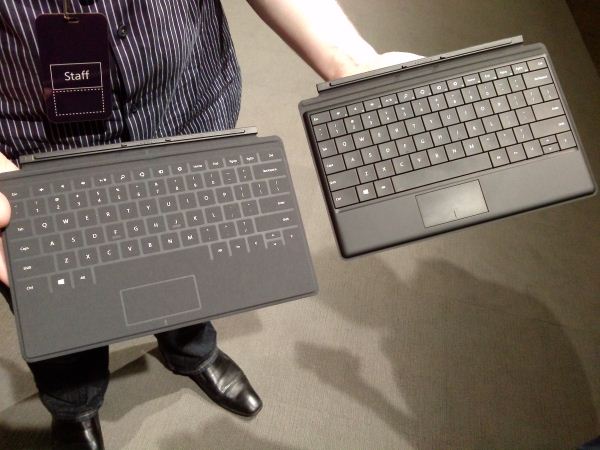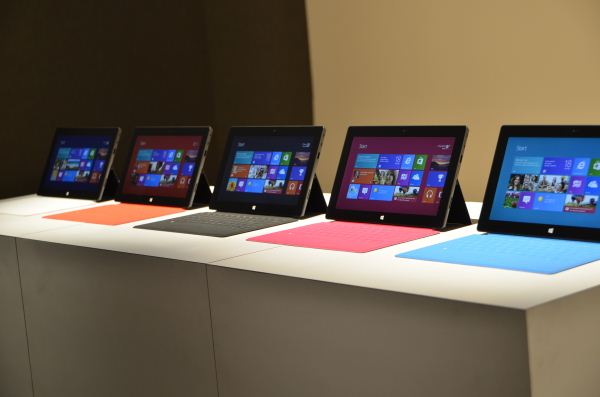Microsoft Surface - We Go Hands On [UPDATE: Detailed Impressions]
by Vivek Gowri on June 18, 2012 11:32 PM ESTPost-announcement, Microsoft took us to a backroom in Milk Studios to give us hands on experience with the Surface. They weren't lying, even the preproduction units feel awesome in hand. The magnesium panels are finished with partial vapour deposition, a process that deposits a thin-film coating onto the panel using vacuum deposition (molecule-by-molecule deposits at sub-atmospheric pressure.) It gives the unit a distinctly premium feel, and one that's pretty different from most of the other metal-bodied systems out there particularly with the current trends towards anodization and brushed finishes. The body is 9.3mm thick (a tenth of a millimeter thinner than the latest iPad), and total weight comes in at 676g (or about 1.49 lbs), so it's denser feeling than the iPad.. The 31.5Wh battery isn't as large as the iPad's 42.5Wh, but the 1366x768 10.6" LCD definitely draws less power.
The hinges in the kickstand are spring-loaded, giving a very positive mechanical feel and noise. The hinge mechanism is particularly robust, and as mentioned in the keynote, was acoustically tuned to sound high quality. Microsoft seemed particularly OCD about certain design details, this being one of them. It paid off though, with a hinge that looks and feels ready to take a lot of abuse. The stand props the system up at 22 degrees, which is a common theme - the beveled edges are all angled at 22 degrees, and the rear camera is also angled at 22 degrees in the opposite direction. This is a pretty interesting one, since it means you can keep the tablet angled as is usually comfortable, and still shoot video straight ahead. It's a good idea, though probably one that will take a bit of adjustment in real life use.
My personal favourite part of the Surface is the cover. There's two of them - the Touch Cover, and the Type Cover, both with integrated keyboards and touchpads. The Type Cover has a traditional keyboard, albeit one with particularly shallow feel, along with physically clicking mouse buttons. The Touch Cover is very interesting - it has a pressure sensitive membrane keyboard with felt keys and mouse buttons housed in a cover that's totally 3mm thick. (The Type Cover is ~5.5mm thick). I wasn't able to get a feel for how typing actually feels on it, so I can't comment on responsiveness or accuracy, but our friend Ben Reed at Microsoft Hardware swears he can top 50 words per minute on it any given day. I'm inclined to believe him, but I can't comment firsthand until I can actually play with a working unit.
The outside of the covers is covered in a felt material, and when closed, the unit feels like one of the velour or felt-covered journals. It gives a decidedly organic, natural feel to a very inorganic device, something that Microsoft was very pleased to note. It's a pretty awesome idea, actually, taking the best parts of Apple's Smart Cover and ASUS' laptop dock and merging them together into one of the most innovative cases we've seen. I took away three major things from this event, and the only one them that directly related to the device hardware being shown off was that integrating the keyboard into the cover was a stroke of awesome. (I'll go more in depth on the others in a larger post later today.)
For the first time, I can really see a tablet replacing a notebook as my primary computing device. Before today, I couldn't say that with any real conviction - I tried it with the iPad on multiple occasions, and it just didn't work. I'm a writer, tablets aren't ideal for writing. Surface changes that in a big way. And that's really what Microsoft is going for here - a device that fits into your life as a versatile tool to do anything you want it to. Whether they'll succeed in capturing the market is a story that will be told after Surface launches alongside Windows 8 later this year, but for now, this is a very promising start.




















161 Comments
View All Comments
faizoff - Monday, June 18, 2012 - link
They look excellent. About time.Patflute - Monday, June 18, 2012 - link
Apple will try to compete etc.Can't wait to see what Google comes up with at the end of the month.
pxavierperez - Tuesday, June 19, 2012 - link
There are already gazillions third party iPad cases that has a keyboard embedded on it. More like this is Microsoft attempt at competing with Apple.Either way, if this thing can run 3DMax, i'm sold. Love my Thinkpad but this could be a good replacement. No info on whether it has an IPS screen or not. I'm assuming it's the former.
damianrobertjones - Tuesday, June 19, 2012 - link
3DSMax- Windows RT = Nope.
- Windows 8 = Possibly but that would be with the intel HD4000
mcnabney - Tuesday, June 19, 2012 - link
Not IPS3DMax on Intel integrated graphics (even the HD4000) is kind of funny.
While RT's resolution sucks outright, the expensive one running Win8Pro is still stuck in 16x9 1080p-land. NOT suitable for a real work due to the letterboxiness of the screen.
JeffFlanagan - Tuesday, June 19, 2012 - link
Maybe letterbox is bad if you're just typing a document, but for real work it's far superior as it allows an array of tools on the right and left of the screen while still displaying the entire document in the center.mcnabney - Tuesday, June 19, 2012 - link
Are you insane? Office tools are all stuck on a RIBBON across the top. Only a few select graphical tools put the tools to the side and I can guarantee that that $1000-2000 displays that graphic artists use are NEVER 16x9.The only thing that letterbox is good for is watching movies.
agentbb007 - Tuesday, June 19, 2012 - link
You guarantee graphics artists don't use a 16x9 display? Want to put some money on that ;) because I know an entire studio who work entirely on Apple's cinema display which is 16x9...repoman27 - Tuesday, June 19, 2012 - link
The mid 2010 27-inch LED Cinema Display, and mid 2011 27-inch Apple Thunderbolt Display are the only 16:9 aspect ratio standalone displays Apple has released. All the other Cinema Displays were 16:10 (or 25:16 in the case of the old 22-inch models). And to be honest, there's not a lot of panels out there that offer more than 1440 vertical pixels anyway, so the aspect ratio isn't really limiting your workflow.StevoLincolnite - Wednesday, June 20, 2012 - link
Just rotate the Tablet in a 90 degree angle and use a USB keyboard? SUDDENLY you have 1920 pixel of vertical space. :D